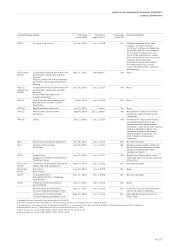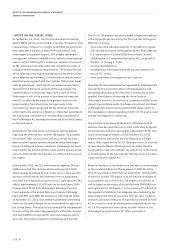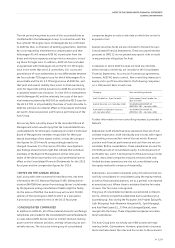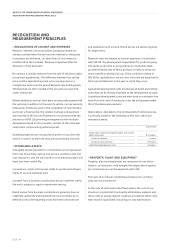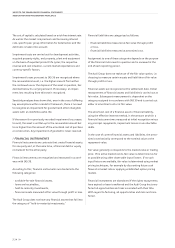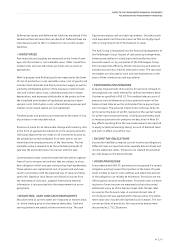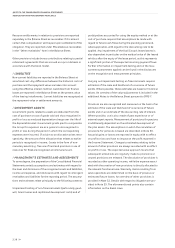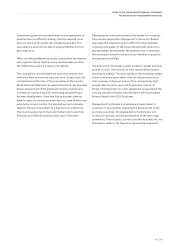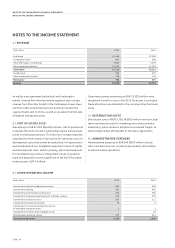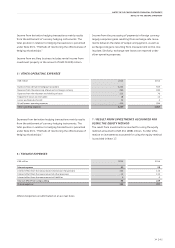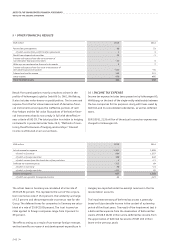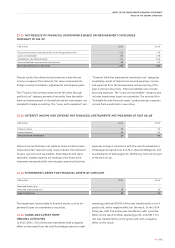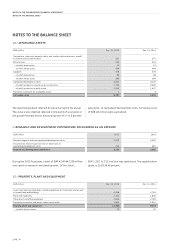Audi 2015 Annual Report Download - page 236
Download and view the complete annual report
Please find page 236 of the 2015 Audi annual report below. You can navigate through the pages in the report by either clicking on the pages listed below, or by using the keyword search tool below to find specific information within the annual report.
NOTES TO THE CONSOLIDATED FINANCIAL STATEMENTS
RECOGNITION AND MEASUREMENT PRINCIPLES
236 >>
Where there is evidence that the fair value of the securities
and participations is lower, the corresponding value adjust-
ments are carried out. As of the balance sheet date, there is no
intention to sell any material participations.
// DERIVATIVE FINANCIAL INSTRUMENTS AND
HEDGE ACCOUNTING
Derivative financial instruments are used as a hedge against
foreign exchange and commodity price risks for items on the
Balance Sheet and for future cash flows (underlying transac-
tions). Futures, as well as options in the case of foreign
exchange risks, are taken out for this purpose.
Additionally, under the rules of IAS 39, some contracts are
classed as derivative financial instruments:
>rights to acquire shares in companies,
>agreements entered into by the Audi Group with authorized
dealers with a view to hedging against potential losses from
buy-back obligations for leased vehicles.
According to the rules, hedge accounting is used if a clear
hedging relationship between the underlying transaction and
the hedge is documented and its effectiveness demonstrated.
Recognition of the fair value changes in hedges depends on the
nature of the hedging relationship.
When hedging against exchange rate risks from future cash
flows (cash flow hedges), the fluctuations in the market value
of the effective portion of a derivative financial instrument are
initially reported within equity in the reserve for cash flow
hedges, with no effect on profit or loss, and are only recog-
nized as income or expense under operating profit once the
hedged item is due. The ineffective portion of a hedge is rec-
ognized immediately in profit or loss. Derivative financial
instruments that are used to hedge market risks according to
commercial criteria but do not fully meet the requirements of
IAS 39 with regard to effectiveness of hedging relationships
are categorized as “measured at fair value through profit or
loss.” Rights to acquire shares in companies, and the model for
dealer hedging against potential losses from buy-back obliga-
tions for leased vehicles, are also reported in the Balance Sheet
in accordance with the rules for “financial instruments measured
at fair value through profit or loss.” The results from “financial
instruments measured at fair value through profit or loss” are
reported under the financial result.
/OTHER FINANCIAL ASSETS AND
OTHER RECEIVABLES
Other financial assets and other receivables are recognized at
amortized cost. Provision is made for discernible non-recurring
risks and general credit risks in the form of corresponding
value adjustments.
/DEFERRED TAX
Pursuant to IAS 12, deferred tax is determined according to the
liability method in combination with the temporary concept.
With this concept, deferred taxes are recognized for all tempo-
rary differences arising from the different valuations of assets
and liabilities in the Balance Sheet for tax purposes and in the
Consolidated Balance Sheet. Deferred tax assets relating to tax
loss carryforwards must also be recognized.
Deferred tax assets include future tax relief resulting from
temporary differences between the carrying amounts in the
Consolidated Balance Sheet and the valuations in the Balance
Sheet for tax purposes. In addition, deferred tax assets relat-
ing to tax loss carryforwards and deferred tax assets from tax
relief are also recognized, if it is likely that they will be used.
Deferred tax liabilities depict future tax charges and are gener-
ally recorded for all taxable time differences between the
figures posted in the tax balance sheet and those in the
Consolidated Balance Sheet.
Deferrals amounting to the anticipated tax burden or tax relief
in subsequent fiscal years are created on the basis of the antic-
ipated tax rate at the time of realization. In accordance with
IAS 12, the tax consequences of distributions of profit are
never recognized until the resolution on the appropriation of
profits is adopted. The measurement of deferred tax assets for
tax loss carryforwards is generally based on future taxable
income in the context of a planning period of five fiscal years.
The carrying amount is reduced for deferred tax assets that are
unlikely to be realized.



